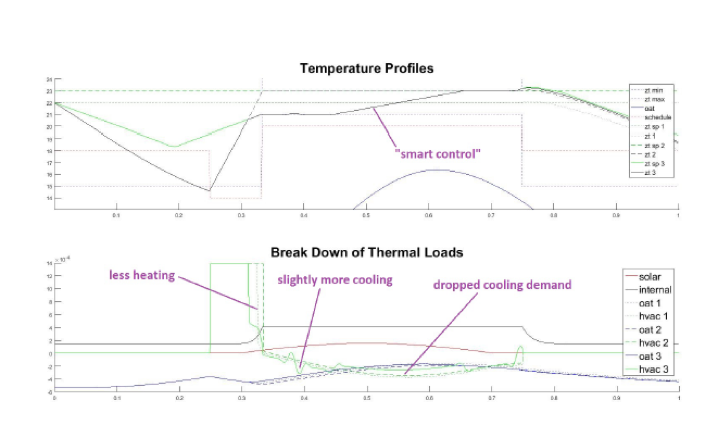
Blog

Spikes in Electricity Prices Place a Costly Burden on Australians and Businesses
July 17, 2017
The Smart Building’s Role in a Smart City
August 15, 2017Nowadays, Artificial Intelligence seems to be everywhere. It’s been tested and has proven efficient by using it to play backgammon, the game of go and even Atari games. In some ways AI is catching up and overtaking us. One space that may not sound sexy, but there is huge potential to apply AI is the field of HVAC – that’s right heating, venting and air-conditioning. HVAC systems are under-appreciated technologies. It falls into the category of technology that a person uses every day and would hate to live without.
So, is there a way to apply the same smart control algorithms that have proven efficient in playing games to a commercial HVAC system that requires coordination of hundreds of control loops? To answer this, let’s start with simulation.
The goal to creating an HVAC simulation and eventually applying AI is to reduce the amount of energy used, the cost of energy and peak demand – the period in which energy is expected to be consumed at significant higher than average rate. Depending on the local utility, the price of energy for commercial buildings changes depending on time of day and season. Times of peak demand are often the most expensive times to use energy and occur during the hottest hours of the day – when HVAC is need the most. Some utilities also use a building’s highest peak in energy usage to set rates and apply costly demand fees. The ability to optimize the amount of energy used, the amount spent on energy and energy used during times of peak demands will greatly impact operating costs.
Below is a thermal model of a building that is probably the simplest HVAC simulation. This simulation can show how energy, the price of energy and peak demand can be reduced by optimizing the room temperature setpoint.

Figure 1
In the outlined simulation,
- the model considers the whole building as a single zone, in which the building façade, the internal air, the furniture, etc., are always in thermal equilibrium;
- the thermal loads on this zone are treated as signals that generate from stochastic processes;
- The stochastic processes and the parameter values of the thermal model are chosen to correspond to a realistic building;
- the HVAC power is the product of the absolute value of the HVAC thermal load and a cooling or heating factor;
- the cooling factor changes with outdoor air temperature (OAT) in a threshold linear equation.
Controlling room temperature is almost like controlling speed when riding a bicycle. Considering the simple thermal model presented here, the dynamic equations of the two problems are almost identical.
In the case of riding a bicycle, there are a number of forces that change the speed of the bicycle. When an individual pedals, there is a force pushing the bicycle and the rider forward. There are also various other forces, such as friction and gravity, pulling the bicycle backward. When these forces add up to zero, the bicycle travels at constant speed.

Figure 2
In the case of a HVAC system, there are a number of thermal loads that change the temperature of a room. The HVAC system usually blows cold air into the room and decreases the room temperature. There are also a number of other thermal loads, such as human activity and solar radiation, that increase the room temperature. When these thermal loads add up to zero, the room temperature is fixed.
Imagine that we are riding on the road with downhill and uphill, will we ride at constant speed? Probably not. We will ride faster going downhill, building up that kinetic energy for the subsequent uphill. Considering this, why would we want to keep our room temperature fixed? If only we can give a comfort range to the room temperature setpoint then we can catch up on the downhill and uphill of the thermodynamics of the room as the outside air temperature and various thermal loads change throughout the day. With patented technology, BuildingIQ is one of the earliest and most well-known companies in the industry that perform this kind of HVAC optimization.
This room temperature “comfort range” is very different from the “deadband” commonly implemented in VAV boxes. The VAV box is the centerpiece of a Variable Air Volume (VAV) system that changes the air flow rate based on the local room temperature and, usually, a pair of setpoints. The “deadband” prevents the VAV damper from actuating all the time. A smart control algorithm can actively optimize the room temperature setpoint within the comfort range, but the actual room temperature is still free to wander within the “deadband” centered at the optimized setpoint at any point in time. Energy saving can be achieved by widening the “deadband”, but without optimization, the room temperature may go against the thermodynamics of the room wasting energy overcooling or overheating. This is the equivalent of trying to ride the bicycle slower going downhill, but faster going uphill.
Results from the simulation shows that room temperature optimization has a great potential to improve HVAC efficiency. The simulation period is a whole year and the following three room temperature control strategies are compared with each other.
- Fixed at 22°C (71.6°F)
- Fixed at 23°C (73.4°F)
- Optimize between 21°C (69.8°F) to 23°C (73.4°F).

Figure 3: Monthly comparison of HVAC energy of a simulation over a whole year
The above graph shows the results of the simulations using three different control strategies. With optimization, the monthly HVAC energy savings range from 5 percent to 24 percent from month to month. The greatest savings are achieved when the building requires some heating and some cooling on the same day. This is to be expected. As the smart control is put to work, some heating is reduced in the morning and hence there is less of a need for cooling later in the day – just like riding a bicycle. This is outlined in Figures 4, as we zoom in on one of these simulated days.

Figure 4a: Single Day of Simulation

Figure 4b: Single Day of Simulation
Through the simulation, peak demand can also be optimized by cooling a bit more in the morning and less during the highest demand period of the day. This is shown in Figure 5.

Figure 5a: Single Day of Simulation with Zone Temperature Setpoints also Optimized for Peak Demand

Figure 5b: Single Day of Simulation with Zone Temperature Setpoints also Optimized for Peak Demand
The simulated energy saving varies depending on the simulation scenario, i.e., the stochastic processes and the parameter values of the thermal model. Likewise, the actual amount of saving varies depending on the property of the actual building.
Although the HVAC simulation that is used within the article is overly simplified, it captures and emphasizes one of the most important relationships between internal condition, external condition and HVAC operation. There are many ways in which the simulation can be expanded and improved. For example, the building facade can be modeled as a separate entity that conducts and stores heat; more zones can be modeled that interact with each other and have different thermal load profiles; the HVAC thermal load can be modeled as it is being delivered by the air loop and water loop; the solar thermal load can be modeled based on the building geometry and material. The simple simulation presented in this article is quite informative in testing and evaluating different room temperature optimization strategies, such as constrained optimization, dynamic programming and the more generic reinforcement learning. In the language of reinforcement learning, simulation provides an “environment” for the intelligent “agent” to interact with and train on. The simple simulation is like training level 1, which should be the easiest to pass.
The various model parameters and thermal loads often need to be estimated first for a building before optimization can be applied. The success of such optimization depends on how well the model parameters and thermal loads can be estimated. Simulations like the one described also provide a test framework for this estimation. From experience, compared to room temperature optimization alone, greater energy savings can be achieved when it is combined with diagnostics, comfort voting application and SAT/SAP optimization. Diagnostics help to make sure that the HVAC system can deliver a prescribed room temperature setpoint in the most efficient way. This step should come before room temperature optimization and continue to monitor the building throughout. Comfort voting application helps to adjust and widen the comfort range improving comfort, providing more ‘room’ for the optimization and hence saving more energy. SAT/SAP optimization also contributes to energy saving but it is not necessary for room temperature optimization to work in a variable air volume system. This is equivalent to changing gears on the bicycle: even without changing gears, we can still optimize our speed based on terrain.
In conclusion, the article demonstrates a simple HVAC simulation and shows how the room temperature setpoint can be optimized. Simulation results show that smart control strategies, such as the ones implemented by advanced intelligent energy management platforms like BuildingIQ, can greatly reduce HVAC energy consumption and demand. Although the technology is not yet widespread, your building may be controlled by an AI-platform and you may not even know it.

Dr. Rui (Ray) Xu is Data Scientist at BuildingIQ. During his career, he has encountered many challenges in the transfer of human knowledge into machines, the interpretation of results of algorithms into human intuition, and the verification of evolving strategies. This experience has helped him to solve some of the most difficult and interesting problems in the industry. He describes himself as a bit quiet but also very energetic and assertive when there is a mathematical, simulated and/or experimental proof behind the scenes.



